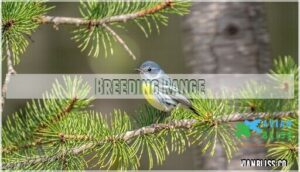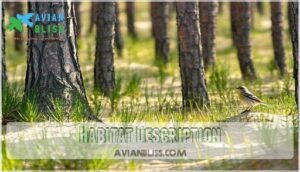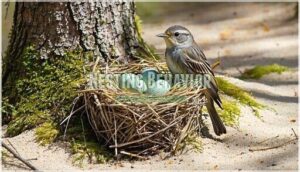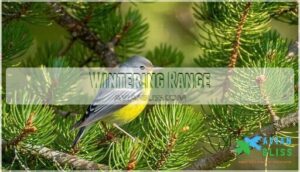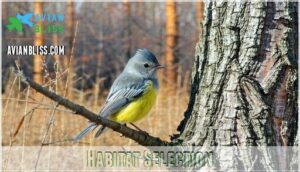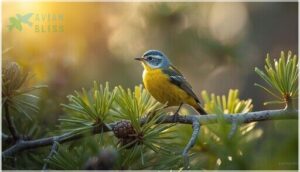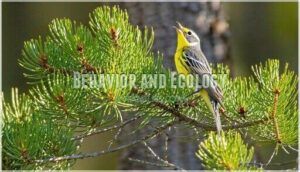This site is supported by our readers. We may earn a commission, at no cost to you, if you purchase through links.

This warbler’s picky taste in real estate makes its survival a nail-biter, relying on forest fires or savvy humans to keep its habitat fresh.
You might spot it flitting low to the ground, singing its heart out, while dodging cowbirds and other threats.
Conservationists have worked tirelessly to keep it off extinction’s doorstep. Stick around—there’s more to this bird’s comeback story than meets the eye.
Table Of Contents
- Key Takeaways
- Kirtland Warbler Overview
- Breeding and Habitat
- Migration and Wintering
- Conservation Status
- Behavior and Ecology
- Frequently Asked Questions (FAQs)
- How rare is Kirtland’s warbler?
- Where do Kirkland warblers nest?
- How do you identify a Kirtland’s warbler?
- Where is the best place to see Kirtland’s warbler?
- How many Kirtland’s warblers are left?
- Where does the Kirtland warbler live?
- What is the rarest warbler in the world?
- What threats do Brown-headed Cowbirds pose?
- Why are controlled burns important for their habitat?
- How long do Kirtlands Warblers live?
- Conclusion
Key Takeaways
- You’ll spot Kirtland’s warbler only in young jack pine forests, mostly in Michigan, making it one of North America’s rarest songbirds.
- You need fire or active habitat management to keep their nesting grounds suitable—without it, these birds can’t survive.
- You’ll see threats like cowbird parasitism, habitat loss, and climate change putting their population at risk.
- You can thank decades of conservation for boosting their numbers from near extinction, but ongoing efforts are still crucial.
Kirtland Warbler Overview
You’ll recognize the Kirtland’s Warbler by its distinctive gray-and-yellow plumage and habit of bobbing its tail while perched in pine trees.
This rare songbird, scientifically known as Setophaga kirtlandii, stands out as one of North America’s larger warblers with steel-gray upperparts and bright lemon-yellow underparts.
Scientific Classification
You’ll find the Kirtland’s Warbler sitting at a fascinating crossroads in bird taxonomy.
This songbird belongs to the wood-warbler family Parulidae within the vast order Passeriformes, representing one of North America’s most specialized species.
- Scientific name: Setophaga kirtlandii (genus Setophaga means "moth-eating")
- Family: Parulidae (New World warblers)
- Order: Passeriformes (perching birds)
- Etymology: Named after Dr. Jared Kirtland in 1851
Physical Description
You’ll recognize Kirtland’s warbler (Setophaga kirtlandii) by its striking plumage details. This Passeriformes member displays blue-gray upperparts with black streaking, contrasting beautifully with bright lemon-yellow underparts.
Males sport distinctive jet-black eye masks and white eye-rings, while females show more subtle markings with additional chest streaking. Both sexes share the species’ signature white rump patches visible during flight.
Among warbler species, it’s remarkably larger with a distinctive tail-bobbing habit that aids bird identification, and this feature is key to its bird identification and noticing its white rump patches.
Identification Features
You’ll spot Kirtland’s warbler by its steel-gray head, bright yellow underparts, and distinctive white eye-ring.
Males display a jet-black eye mask that females lack.
Watch for their unique tail-bobbing behavior – similar to Prairie Warblers.
The white rump flashes during flight, distinguishing this rare bird from Yellow-rumped Warblers.
Listen for males’ curt, warbly vocalizations during breeding season.
Breeding and Habitat
When you find a Kirtland’s Warbler during breeding season, you’re looking at one of North America’s most habitat-specific birds in action.
These yellow-and-gray songbirds nest exclusively in young jack pine forests between 5-20 feet tall, requiring sandy soils and dense ground cover that only Michigan’s fire-adapted ecosystems can provide.
Breeding Range
You’ll discover that Kirtland’s Warbler has one of North America’s most restricted breeding ranges. This Michigan bird depends entirely on specific conditions that create perfect Jack Pine habitat for nesting sites.
- Primary Range: Over 95% nest in Michigan’s northern Lower Peninsula across just 13 counties
- Recent Range Expansion: Small populations now breed in Ontario (since 2008) and Wisconsin (since 2015)
- Habitat Fragmentation: Climate impacts threaten breeding success as suitable jack pine habitat becomes increasingly scattered
To improve nesting success, consider providing artificial nesting sites in suitable areas.
Habitat Description
You’ll find this habitat specialist thriving in young jack pine forests, typically 5-15 years old and 5-15 feet tall.
These kirtlands warbler require sandy soil composition and dense lower branches with minimal undergrowth.
Jack pine needs specific fire ecology for regeneration, as cones remain sealed until forest fires trigger reseeding.
Habitat fragmentation threatens nesting sites, making habitat restoration essential for maintaining suitable jack pine habitat across their limited breeding range.
Nesting Behavior
When you’re watching Kirtland’s Warblers during bird breeding season, you’ll notice their ground nesting behavior follows specific patterns.
These bird behavior specialists construct their nests with remarkable precision, ensuring nest success through careful parental care strategies.
Here’s what makes their nesting behavior unique:
- Nest Construction – Females weave cup-shaped structures using grasses, pine needles, and moss
- Clutch Size – They typically lay 4-5 speckled eggs per breeding attempt
- Nestling Development – Both parents share feeding duties for 9-10 days until fledging
This ground nesters’ approach maximizes reproductive success in their specialized jack pine habitat. You can even find warbler nest products online.
Nest Placement
You’ll find Kirtlands Warbler nests cleverly hidden on the ground beneath young jack pines.
These ground nesters build their homes using grasses, pine needles, and other natural nest materials tucked under dense vegetation.
Ground concealment protects against predators, while jack pine proximity provides essential cover.
Nest density varies based on habitat quality, with vegetation influence determining ideal nesting spots and reducing nest parasitism risks.
Migration and Wintering
You’ll witness one of nature’s most remarkable journeys when Kirtland’s Warbler completes its 1,500-mile migration from Michigan’s jack pine forests to the Bahamas each fall.
This tiny songbird travels from Michigan to the Bahamas, crossing continents on an epic seasonal adventure.
This tiny songbird navigates between two dramatically different worlds.
It spends winters in the dense scrublands of the Bahamas before returning north each spring to breed.
Wintering Range
Nearly all Kirtland’s Warblers escape Michigan’s harsh winters by retreating to the Bahamas, where they’ll spend six months in specialized Bahamas habitat.
This limited range creates unique conservation challenges since threats in their wintering habitat directly impact the entire species.
Here’s what makes their winter home special:
- 98% concentrate in the Bahama Archipelago – primarily on Eleuthera, Andros, Grand Bahama, and Abaco islands, with tiny populations in Turks and Caicos Islands
- Dense pine understory provides essential food sources – insects hiding in Caribbean pine and blackland coppice vegetation sustain them through winter
- Site fidelity runs deep – 72-88% of banded birds return to identical wintering patches year after year, showing strong territorial behavior
- Conservation impact extends internationally – habitat loss from coastal development and hurricane damage in the Bahamas threatens the entire species’ survival
This concentrated wintering pattern means protecting Bahamian pine forests isn’t just local conservation—it’s essential for preventing this remarkable bird’s extinction.
Migration Patterns
You’ll witness Kirtland’s Warblers setting out on extraordinary journeys twice yearly, following predictable Neotropical migration patterns between Michigan’s jack pine forests and the Bahamas.
These remarkable birds navigate specific Flyway Routes, timing their departure from breeding grounds by late August.
Climate Impacts increasingly affect Migration Triggers, while migration hazards threaten their survival during this vulnerable period.
Birds rely on visual landmarks to guide them.
| Migration Phase | Timing | Distance | Stopover Ecology |
|---|---|---|---|
| Spring Northbound | April-May | 1,500+ miles | Deciduous woodlands |
| Fall Southbound | August-September | 1,500+ miles | Coastal thickets |
| Bahamas Wintering | October-March | Stationary | Pine understory |
| Breeding Season | May-August | Territorial | Jack pine stands |
Kirtland’s Warblers face challenges during their vulnerable period, and understanding their migration patterns is crucial for conservation efforts.
Habitat Selection
If you’re picking a bird habitat for Kirtland’s Warbler, focus on these five keys:
- Pine Age—young jack pines are a must.
- Soil Composition—sandy soils support nesting.
- Understory Density—thick ground cover hides nests.
- Fire Ecology—fires help restore bird habitats.
- Habitat Fragmentation—avoid splitting up suitable habitat.
Smart habitat management guarantees survival of the Kirtland’s Warbler, and it is crucial to consider these factors to ensure the bird habitats are well-preserved.
Conservation Status
You’ll find that Kirtland’s Warbler has faced a tough road, once landing on the Endangered Species List for nearly half a century.
Few birds have overcome as many challenges as the Kirtland’s Warbler, a true comeback story in conservation.
Today, you can see how focused conservation efforts and careful habitat management have helped this rare songbird make a remarkable comeback, though challenges remain.
Endangered Species Listing
After learning about wintering grounds, let’s talk about the Endangered Species Listing.
Kirtland’s Warbler landed on the Endangered Species List in 1967, flagged for severe decline.
Listing Criteria focused on population recovery and habitat management.
Legal Protections under the Endangered Species Act shaped bird conservation.
Public Perception grew as the Delisting Process showed real progress, sparking hope for the warbler’s future.
Conservation Efforts
With grit and teamwork, you help keep the Kirtland’s Warbler off the Endangered Species List.
Conservation efforts include:
- Cowbird Control—removing nest parasites.
- Habitat Restoration—planting jack pine forests.
- Population Monitoring—tracking every singing male.
- Funding Strategies—securing dollars for future work.
Spread the word! Public Awareness matters. Even “Reinita de Kirtland” and “Paruline de Kirtland” need your voice to support conservation efforts.
Habitat Management
You’ll see habitat management in action through controlled burns, Jack Pine planting, and cowbird control.
These steps restore nesting habitat and fight habitat fragmentation.
Controlled burning mimics nature, helping jack pine cones release seeds.
Planting jack pine guarantees young forests.
Cowbird control boosts warbler success.
Climate impacts mean ongoing habitat restoration is key.
You can support reforestation efforts by purchasing affordable Jack Pine.
| Controlled Burns | Jack Pine Planting | Cowbird Control |
|---|---|---|
| Restores habitat | Grows new forest | Protects nests |
| Releases seeds | Fights fragmentation | Increases chicks |
| Mimics nature | Guarantees survival | Aids population |
This approach ensures the preservation of natural habitats and supports the growth of new forests, ultimately aiding in the conservation of species.
Threats and Challenges
Every rare bird faces its share of hurdles, and Kirtland’s Warbler is no exception.
You’ll notice the biggest threats include:
- Habitat Loss from development and fire suppression
- Climate Change shrinking jack pine forests
- Cowbird Parasitism reducing young survival
- Wind Turbines disrupting migration
- Funding Cuts risking future population increase
It’s a tough balancing act.
Additionally, plastic pollution further endangers avian species.
The combination of these threats creates a significant challenge for the Kirtland’s Warbler population, highlighting the need for conservation efforts to address Climate Change.
Behavior and Ecology
You’ll notice Kirtland’s Warbler isn’t shy about singing from the treetops or wagging its tail while foraging for insects.
If you’re curious about how this rare bird survives, its behavior and ecology offer plenty of fascinating details.
Diet and Foraging
After decades of conservation, Kirtland’s Warbler relies on a varied bird diet.
You’ll find their foraging locations mostly in dense jack pine branches, tail-pumping as they hunt.
Insect consumption dominates, with spittlebugs and aphids topping prey selection.
Ground foraging is common, especially in winter, when their seasonal diet shifts to berries and fruit—blueberries are a favorite snack.
The warbler’s survival depends on young jack pine for breeding.
Social Behavior
When you watch Kirtland’s Warblers, you’ll notice they’re not big on flocking behavior, preferring loose colonies during breeding season.
Here’s what stands out:
- Males fiercely defend territory, using vocal communication.
- Mating rituals include chasing and singing, with open-cup nests built low.
- Both parents share egg incubation, showing hints of cooperative breeding.
These behaviors are vital, as monogamous bonds guarantee breeding success.
Unique Characteristics
A rare songbird like the Kirtlands Warbler stands out with its distinct plumage—blue-gray above, yellow below, and bold white eye crescents.
You’ll notice its constant tail wagging, a quirky habit among wood warblers.
Its vocalizations are curt and warbly, making identification tricky.
Size comparison helps, too; it’s one of the largest in its group, adding to identification challenges, with its distinct plumage being a key factor.
Interesting Facts
You might find the Kirtlands Warbler’s Unusual Name Origin fun—Dr Jared Kirtland’s Ohio farm hosted one of the first sightings.
This endangered bird’s Tail Wagging habit sets it apart from other wood warblers.
As a Larger Warbler with a Unique Song, it’s a rare songbird.
Limited Sightings mean you’ll need luck to spot one.
Frequently Asked Questions (FAQs)
How rare is Kirtland’s warbler?
You’ll have to look hard to spot Kirtland’s warbler.
It breeds only in young jack pine forests in Michigan, Wisconsin, and Ontario.
With fewer than 2,500 singing males, it’s one of North America’s rarest songbirds.
Where do Kirkland warblers nest?
You’ll find them nesting on the ground, tucked under dense branches of young jack pine trees, often camouflaged by grasses and shrubs.
They like sandy soil and need forests just 5–15 years old for the job.
How do you identify a Kirtland’s warbler?
Spot Kirtland’s warbler by its blue-gray back, lemon-yellow belly, bold black streaks, and white eye crescents.
Watch for its tail-bobbing habit and listen for a curt, warbly song high up in young pines.
Where is the best place to see Kirtland’s warbler?
You’d think a rare bird would hide out somewhere exotic, but nope—your best bet’s northern Michigan’s young jack pine forests.
Visit in mid-May to June, walk sandy trails, and listen for their curt, warbly song.
How many Kirtland’s warblers are left?
You’ll find about 2,300 singing males left, thanks to decades of hard work by conservationists.
That’s a big jump from the 1980s, but every warbler counts when your entire population fits in a school gym.
Where does the Kirtland warbler live?
Imagine hiking Michigan’s jack pine forests and hearing a rare songbird—Kirtland’s warbler breeds only here, in young pines on sandy soil.
Each winter, you’d need to visit the Bahamas’ dense scrub to spot them again.
What is the rarest warbler in the world?
You’re looking at the Kirtland’s Warbler, one of the world’s rarest warblers.
With its picky taste for young jack pine forests, this bird’s population once dipped dangerously low, making every sighting a rare treat.
What threats do Brown-headed Cowbirds pose?
Up to 70% of nests can be parasitized by Brown-headed Cowbirds, meaning you’ll see fewer warbler chicks.
Cowbirds lay their eggs in other birds’ nests, crowding out warbler young, and lowering overall survival rates.
Why are controlled burns important for their habitat?
Controlled burns help you mimic natural wildfires, clearing old trees and allowing young jack pines to grow.
Without fire, jack pine seeds stay locked in cones, and warblers lose their perfect hideaway—no flames, no family reunion!
How long do Kirtlands Warblers live?
Time flies when you’re a songbird—Kirtland’s Warblers usually live about 2 to 5 years in the wild.
Some lucky ones reach 8 years, but hazards like predators, weather, and migration keep lifespans short.
Conclusion
Like a rare jewel hidden in Michigan’s forests, the Kirtland’s warbler shows you how delicate survival can be.
You’ll see its story woven through fire-managed habitats and careful conservation. If you’re ever hiking through jack pines, keep an eye out for its bright yellow belly.
By understanding its needs, you’re helping safeguard a species that relies on teamwork. The Kirtland’s warbler isn’t just a bird—it’s a symbol of hope for endangered wildlife everywhere.
- https://pubs.usgs.gov/publication/5224151
- https://digitalcommons.unl.edu/cgi/viewcontent.cgi?article=1240&context=usfwspubs
- https://animalia.bio/kirtlands-warbler
- https://silvis.forest.wisc.edu/wp-content/uploads/sites/379/2022/02/ACE-ECO-2021-2009.pdf
- https://www.audubon.org/field-guide/bird/kirtlands-warbler


